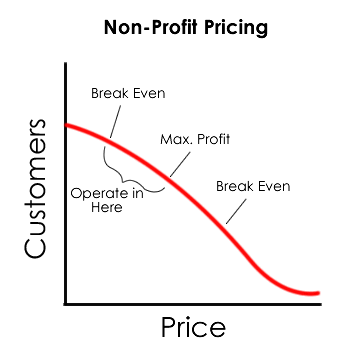How to Charge for Service and Not Lose Customers
Your mission, as a not-for-profit organization, is something other than profits. But if you don’t have enough money coming in, you can’t keep sending money out. This means creating income streams to offset your costs. For most non-profits, that’s fundraising. But for many, fundraising isn’t enough. And this means charging for your service.
Charging a fee for your work is basically the equivalent of company charging for their product rather than giving it away. There’s a major hurdle when you convert a free service to fee for service.
Yay, More Problems!
It’s not the fact that you’re asking for money. People are used to this – they pay for stuff all the time and are often wary of anything “free.”
The hurdle is your customer base—can they afford your service? The answer lies in two words: pricing and segmentation.
Pricing is the art and science of maximizing profit. Since your goal isn’t necessarily profit (though many non-profits may be working hard to establish a surplus for growth or stability), you might consider pricing in terms of maximizing mission. What price allows you to serve the most customers in a sustainable way?

Uh oh, some people can’t afford it. So what do you do when you need to charge for service, but you want/need to provide the service to people who can’t afford the service?
Imaginary example
Let’s imagine your product is priced at $10. While many people will pay $10, some people would be willing pay $14 and some will only pay $7. But how can you get people to pay as much as they can/will pay?
One approach is to simply ask people to pay what they can. This only works as long as people are honest about what they can afford, and even then most people aren’t honest with themselves about what they can afford. It’s also not very predictable.
Another approach lies in something called price discrimination. This isn’t a negative thing, it’s just the term for charging a different price for different customers. Give customers a way to pay less than the full price and the ones who can’t afford full price will take those options. It’s also an excellent way to balance out a price increase, in case you’ve already been charging for your service.
Give me real world examples
One example is coupons: people who clip coupons are less likely to afford your full price. They use coupons to bring prices down to an affordable level for their budgets. But people who can easily afford your service will rarely bother – it’s easier to just pay full price.
Another example might be an “earn your way to camp” approach. At Camp Fire, we offer ways to earn money toward camp through various fundraisers – a car wash, selling pizzas, etc. You don’t have to do these things, but they’re fairly easy ways to cut the price down. Another way is through referrals, where each referral results in a discount.
Finally, we offer the campership program for our customers who have demonstrated financial need yet wish to come to camp. We’ve worked hard to raise money for this program. I’ll write a post about this later, but it’s all part of our pricing plan.
The Role of Fundraising
As a non-profit, one of your advantages is in pricing. As you’re not focused on profits, you may charge less than a for-profit counterpart (if such a thing exists). Fundraising is one way to balance this. If your annual operating budget is $100,000 but you can bring in $30,000 from fundraising, then you can knock 30% off the price and still break even.
The Moral
Pricing and “price discrimination” are important concepts to consider as you charge for your organization’s services. As a business focused on your mission, you have to develop a healthy source of income. It doesn’t make sense to charge for all services – some just won’t work that way. But many can find a healthy mix of fundraising and fees to build a stable, growing organization.
Want to comment? Send me a note on Twitter or email me.